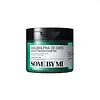What's inside
What's inside
 Key Ingredients
Key Ingredients

 Benefits
Benefits

 Concerns
Concerns

 Ingredients Side-by-side
Ingredients Side-by-side

Salix Alba Bark Water 85%
AstringentButylene Glycol
Humectant1,2-Hexanediol
Skin ConditioningGlycerin
HumectantSodium Hyaluronate
HumectantBetaine Salicylate 0.5%
AntimicrobialArtemisia Princeps Leaf Extract
Skin ConditioningCentella Asiatica Extract
CleansingMelaleuca Alternifolia Leaf Water
AntimicrobialChamaecyparis Obtusa Leaf Extract
Skin ConditioningOpuntia Ficus-Indica Extract
Skin ConditioningHouttuynia Cordata Extract
Skin ConditioningMelia Azadirachta Leaf Extract
Skin ConditioningMelia Azadirachta Flower Extract
Skin ConditioningMadecassic Acid
Skin ConditioningAsiaticoside
AntioxidantAsiatic Acid
Skin ConditioningMadecassoside
AntioxidantAllantoin
Skin ConditioningPanthenol
Skin ConditioningArginine
MaskingPEG-60 Hydrogenated Castor Oil
EmulsifyingCitric Acid
BufferingLactobionic Acid
BufferingSodium Hydroxide
BufferingWater
Skin ConditioningBenzyl Glycol
SolventEthylhexylglycerin
Skin ConditioningRaspberry Ketone
MaskingMentha Piperita Oil
MaskingSalix Alba Bark Water 85%, Butylene Glycol, 1,2-Hexanediol, Glycerin, Sodium Hyaluronate, Betaine Salicylate 0.5%, Artemisia Princeps Leaf Extract, Centella Asiatica Extract, Melaleuca Alternifolia Leaf Water, Chamaecyparis Obtusa Leaf Extract, Opuntia Ficus-Indica Extract, Houttuynia Cordata Extract, Melia Azadirachta Leaf Extract, Melia Azadirachta Flower Extract, Madecassic Acid, Asiaticoside, Asiatic Acid, Madecassoside, Allantoin, Panthenol, Arginine, PEG-60 Hydrogenated Castor Oil, Citric Acid, Lactobionic Acid, Sodium Hydroxide, Water, Benzyl Glycol, Ethylhexylglycerin, Raspberry Ketone, Mentha Piperita Oil
 Reviews
Reviews

Ingredients Explained
These ingredients are found in both products.
Ingredients higher up in an ingredient list are typically present in a larger amount.
Citric Acid is an alpha hydroxy acid (AHA) naturally found in citrus fruits like oranges, lemons, and limes.
Like other AHAs, citric acid can exfoliate skin by breaking down the bonds that hold dead skin cells together. This helps reveal smoother and brighter skin underneath.
However, this exfoliating effect only happens at high concentrations (20%) which can be hard to find in cosmetic products.
Due to this, citric acid is usually included in small amounts as a pH adjuster. This helps keep products slightly more acidic and compatible with skin's natural pH.
In skincare formulas, citric acid can:
While it can provide some skin benefits, research shows lactic acid and glycolic acid are generally more effective and less irritating exfoliants.
Most citric acid used in skincare today is made by fermenting sugars (usually from molasses). This synthetic version is identical to the natural citrus form but easier to stabilize and use in formulations.
Read more about some other popular AHA's here:
Learn more about Citric AcidEthylhexylglycerin (we can't pronounce this either) is commonly used as a preservative and skin softener. It is derived from glyceryl.
You might see Ethylhexylglycerin often paired with other preservatives such as phenoxyethanol. Ethylhexylglycerin has been found to increase the effectiveness of these other preservatives.
Water. It's the most common cosmetic ingredient of all. You'll usually see it at the top of ingredient lists, meaning that it makes up the largest part of the product.
So why is it so popular? Water most often acts as a solvent - this means that it helps dissolve other ingredients into the formulation.
You'll also recognize water as that liquid we all need to stay alive. If you see this, drink a glass of water. Stay hydrated!
Learn more about Water